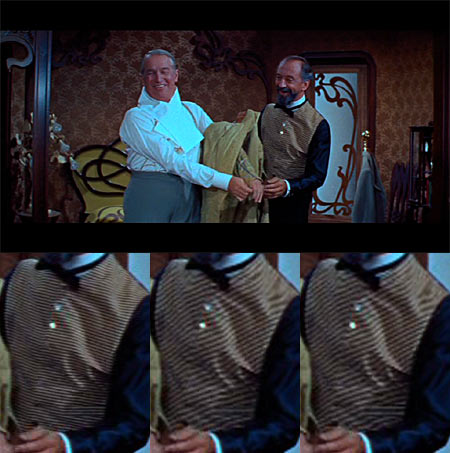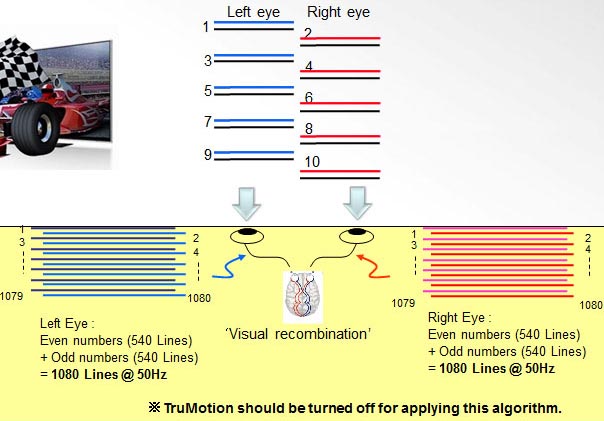Trying to make sense out of what a passive 3D TV is doing, and how we as human beings are seeing its results, is not an easy thing to do. It is complicated by changing standards, misunderstandings, the inability to capture though photographs what’s going on, and the additional layer of complexity due to processing in the brain.
Thanks to commenter Ryan I have had a number of interesting pieces to read, mostly ones which are of the view that LG passive 3D TVs provide full resolution. I remain of the view that this is not correct, after closely examining a new LG passive 3D TV last week. But to make this clearer, I might need to change terminology and stop using the word ‘resolution’, since this is very confusing.
But, before going any further, I must add that I am talking about this subject kind of in isolation from the whole 3D package. In my opinion, the biggest influence on 3D performance is the level of crosstalk or ghosting. The greater the resistance of a technology to this, the better it looks. Ghosting (the breakthrough of left eye information to the right eye and vice versa) confuses the systems in our brains that assemble the 3D composite.
The best 3D I’ve seen so far is active (ie. flashing glasses) available from DLP front projectors. Passive 3D direct view TVs are either equal with, or very closely behind, these. Then a bit further back is direct view plasma (again, active), followed by various active LCD and LCoS systems, both direct view and as front projectors.
One day the whole resolution question on passive 3D TVs will be moot, because eventually double resolution panels will be used so that a full 1080p will be provided to each eye.
But for now, to be entirely clear, if someone said to me that they want a 3D TV with a real emphasis on great 3D performance, I’d recommend a passive one to them, but note that a plasma active system is also very good, while the latest crop of reputable active LCD TVs are quite reasonable.
Some people writing on this subject seem to find the rapid flashing between left and right eye of active systems to be troubling. I don’t at all. But if you do, then clearly that’s another reason to go passive.
Resolution
Now one problem with the discussion so far is the word resolution. One article goes so far as to use it in a highly idiosyncratic way as to include the third dimension of time as part of a definition of resolution.
Me, I like to keep things apart. I use ‘resolution’ in two ways: to list physical specifications, and as a proxy for what might be called picture detail. These aren’t always exactly the same thing.
A Blu-ray disc has a physical resolution of 1,920 by 1,080 pixels. A full HD TV has a physical resolution of 1,920 by 1,080 pixels. With, these days, the default playback settings and a HDMI connection, there is 1:1 pixel pixel mapping between the two.
But there is more to a picture than simply taking one pixel from the disc and putting it in the matching place on the screen. For example, you don’t get a whole lot more effective resolution from the Donnie Darko Blu-ray than you do from the DVD because the source material is relatively low in detail. In that case, a high resolution format is being used to carry low resolution content.
Of course, most Blu-ray content makes considerable use of the 400% increase in the number of pixels compared to (576i) DVD.
So perhaps we ought to talk about data.
And, at least up until recently, and depending on the setting of your TV, data used to get thrown away by passive systems. Depending on how you want to define it, either half the data was thrown away, or up to a half the data was thrown away.
On a rough examination, ‘half’ is the obvious answer. A Blu-ray 3D disc carries two sets of 1080p video content, one set for the left eye, and one set for the right. In 3D mode, a basic passive TV is only capable of showing half of the lines available for each eye. Every second line is blanked out. It has, for each eye, a physical resolution of 540p.
Which lines are blanked out?
I had a strong view, based on my examination of a Toshiba passive 3D TV that the same line was shed from both the left and right eye views. That is, that what you saw was either all the odd lines, or all the even lines, in both eye views.
The general underlying assumption of much of the writing you see around — without it necessarily being explicitly considered — is that it is the other way round. That is
, that the left eye sees, say, all the odd lines and the right eye sees all the even lines.
To try to work out which view is right, I developed a simple test pattern and displayed that on a new LG TV at the company’s new product launch last week. This seemed to indicate that this second approach was the strategy being used: that is, that one eye sees all, and only, the odd lines and the other sees all, and only, the even lines.
I say ‘seemed’ because I was rushed (this was right at the tail end of the formal demonstrations and I had only minutes to spare before having to leave for my flight home). Of course, over the next couple of days I started thinking of variations on the test pattern that would have corroborated my finding.
Furthermore, since then a new possibility has arisen. I’d thought of this, but dismissed it as too unlikely. That is, that both the odd and the even lines were being shown. There would be two ways of doing that: either by merging each odd/even pair into a single new line and showing that, or alternating between the two rapidly.
It turns out that in the last few months LG has introduced a firmware upgrade that does just that. According to a number of websites which apparently quote LG:
Before the Cinema 3D technology worked like this: During a time period of 1/200 seconds the TV showed 2 frames; 540 lines for the left eye and 540 lines for the right eye. The new algorithm shows 4 frames instead of 2 during the 1/200 second time frame. It shows 1080i for the left eye and 1080i for the right eye.
When these are combined the two pictures create a 1080p picture according to LG. LG believes that this update improves picture quality on their Cinema 3D TVs to compete directly with the active 3D TVs such as 3D plasma TVs. You need to turn off TruMotion to utilize the new algorithm. See the illustration below.
And here’s the picture, which again I assume originates from LG:
So we have an explicit statement that previously (or still, unless you switch off the TruMotion frame interpolation system) 3D worked by discarding every second line. Now (if you switch off TruMotion) you get the odd and even lines flashed extremely rapidly in 3D mode up onto the same display line.
I do not know what the setting was for the TV I examined last week. I didn’t know about this firmware upgrade then. It is possible with the test pattern I used that what I saw was in fact both lines flashing rapidly between each other. But for the time being I am going to assume that the passive image we are talking about consists of odd lines only for one eye, and even lines only for the other. One day I will return to LG’s firmware upgrade.
Now Dr Soneira argues that when your eyes see the left and right images, the content is piped into your brain and your visual processing circuits perform something he calls ‘3D Image Fusion’.
No argument from me. Obviously your eyes do take in separate images that are similar, but not identical. But you do not see two separate images, you see one with certain characteristics which give you a sense of depth. The parts of our brains which process vision do so in such a way as to provide useful, actionable sensory information. And that’s what it has settled on to help us deal with information about proximity.
Dr Soneira then posits that as part of the process of 3D Image Fusion, the content from the half-resolution left and right eye images are merged together in such a way that the brain effectively constructs a full resolution amalgam.
This makes a certain degree of sense, and there are cases where you would think it would work rather nicely. But in those cases it simply doesn’t.
Again I took with me to Sydney to the LG launch my trusty Blu-ray 3D disc of Cats and Dogs 2: The Revenge of Kitty Galore. You will recall that the point of interest with this is its main menu:

Although 3D, most of it is presented flat, with no left/right parallax differences. I popped the disc into a Blu-ray player, displayed the menu, and invited one of my editors over as witness. There were the jaggies I’ve previously mentioned, and the loss of detail on the dog’s fur. Because the image is flat, you can slip the glasses on and off to check the difference.
I carefully stood at various ranges, including 3x screen height (it was a 55 inch TV, so the range for that is two metres), plus even further back. The jaggies and loss of detail were easily visible at all ranges. With both eyes open of course.
Dr Soneira allows that 3D Image Fusion fails sometimes (scroll up three paragraphs):
3D Image Fusion may not work well when there is insufficient image context to allow the brain to pair up the parallax from the right and left eye images. With FPR that happens when there is content with very thin nearly horizontal line structures that occur in high contrast situations.
As an aside, he is surprisingly forgiving of this (‘That’s generally acceptable because they are seldom noticeable and every technology has at least some occasional issues and limits.’)
But the failure does caste doubt on his thesis in my view. Here are two possible explanations for his observed phenomena:
- a process of 3D Image Fusion restores full resolution almost all the time by combining the odd and even scan lines, which are seen by different eyes, into one full image. However it doesn’t work sometimes.
- a process of 3D Image Fusion occurs which creates a 3D image, but with only half the vertical resolution of the source content for each eye. If viewed at the recommended range then the loss of vertical resolution is not particularly noticeable, except with certain hard diagonal edges, in which jaggies are always more visible than with naturalistic content.
I think you can make a reasonable case for 2.
I note that in Dr Soneria’s discussion of fusion failure, he discusses some scenes which exhibit moire. But as it happens, the appearance of moire is precisely what I use as a marker for poor progressive scan conversion of 576i50 DVDs, and 1080i50 Blu-ray discs! It is too uncertain in my opinion, even with a close viewing range and a full HD front projector, to determine whether a deinterlacer is correctly weaving the fields of progressive sourced content together, or incorrectly treating them as video sourced and therefore bobbing together any moving content. The latter means that half the resolution is being displayed at any instant.
I discuss this fully here. But here is an illustrative image from the 576i50 test clip I constantly use for testing TVs and various disc players. Top is the full frame, scaled down to fit. The bottom three are unscaled from the source and are, left, the two fields properly woven together, middle, the field containing the odd lines only, and right, the field containing the even lines.

Moire on near horizontal diagonals is actually a clear marker of half vertical resolution.
Two thousand words is enough for one blog post, even though I haven’t covered everything. So I expect to return to this subject. But I might hold off until I’ve got my hands on a new LG passive 3D TV for a week or two. Then I can run a bunch of tests, real world and test pattern, to either enhance, or perhaps overturn, my present view.


4 Responses to 3D: Passive vs Active redux